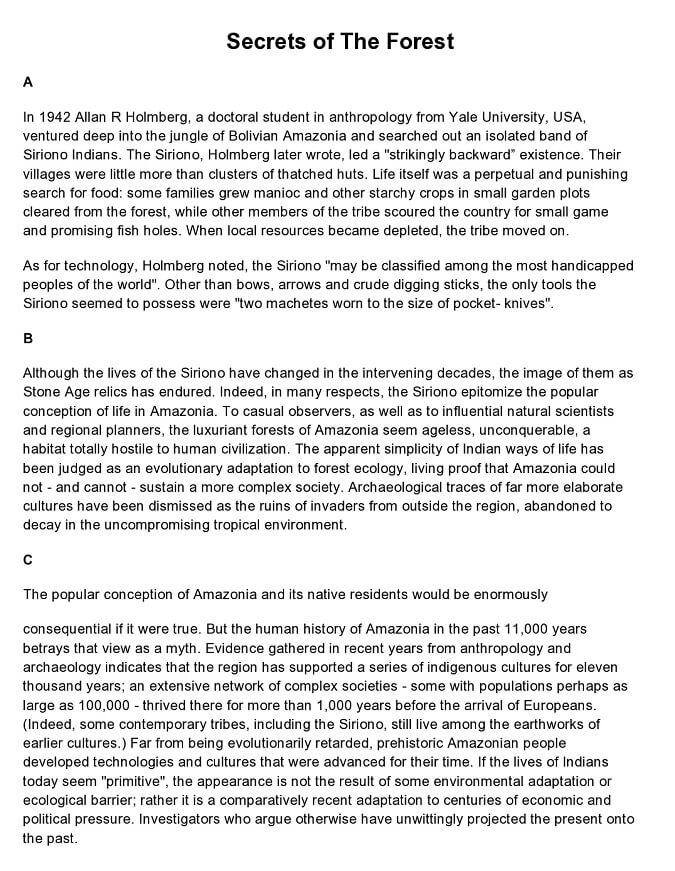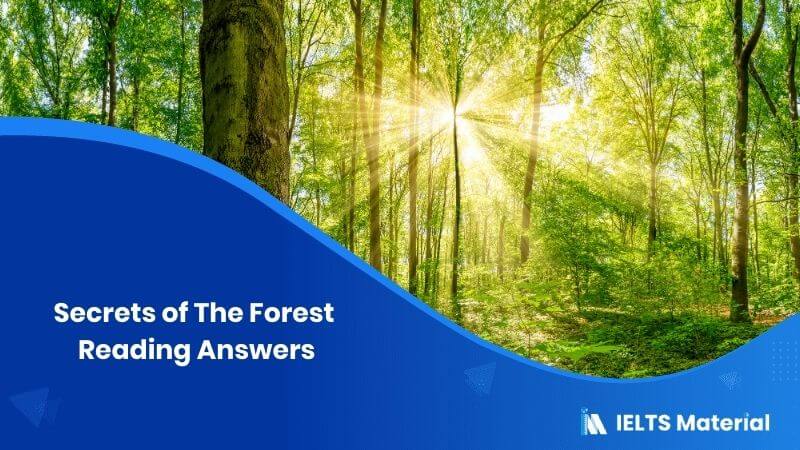Secrets of The Forest Reading Answers
7 min read
Updated On
-
Copy link
Table of Contents

Limited-Time Offer : Access a FREE 10-Day IELTS Study Plan!
The Reading Module of the IELTS can be the top-scoring category, with diligent practice. To achieve the best results in this section, you must understand how to approach and answer the different Question types in the Reading Module. By solving and reviewing Sample Reading Questions from past IELTS papers, you can ensure that your Reading skills are up to the mark.
The Academic passage ‘Secrets of the Forest’ is a reading passage that appeared in an IELTS Test.
The question types found in this passage are:
Matching Headings
In this type of question, a list of headings will be given and you are asked to match these headings with a paragraph in the passage. You should read the headings before you begin reading the text. To get the correct answer, you have to read the complete paragraph and not just stop with the first few lines of the paragraph. There will also be many other headings that are not related to any of the paragraphs given in the passage, in such cases, try to identify those types of headings too.
Yes/No/ Not Given
Similar to the True/False/Not given questions, Yes/No/Not given questions also have various statements. But here you are asked to agree or disagree with the statement based on the opinion of the author.
Multiple Choice Questions
IELTS reading multiple choice questions have about 3-4 options from which we have to choose our answer. This might be in the form of a question & answer type or a choose a correct ending to a sentence type. These answers appear in chronological order according to the passage.
Read the passage below and answer questions 1 – 13. Beyond the questions, you will find the answers along with the location of the answers in the passage and the keywords that help you find out the answers.




Answers
Unlock Answers
1.
Answer: v
Question type: Matching Headings
Answer location: Paragraph A, line 1
Answer explanation: The answer is clearly mentioned in the said paragraph and line and states that in 1942, Allan R Holmberg, has ventured deep into the jungle of Bolivian Amazonia and searched out an isolated band of Siriono Indians. So, you can understand that the word ‘Amazonian’ has been mentioned in relation to ‘searched out’ which is paraphrased as revealed.
2.
Answer: i
Question type: Matching Headings
Answer location: Paragraph B, line 4
Answer explanation: The answer is clearly mentioned in the said paragraph. The phrase in the said line that ‘Amazonia could not – and cannot – sustain a more complex society’ supports the fact that Amazonia is unable to sustain complex societies.
3.
Answer:vi
Question type: Matching Headings
Answer location: Paragraph D, line 4
Answer explanation: The answer is clearly mentioned in the said paragraph and line. The last line of the paragraph acquaints us with the fact that the natural history of Amazonia is tied to the activities of its prehistoric inhabitants, where ‘tied to’ can be paraphrased as ‘influenced by’.
4.
Answer:Yes
Question type:Yes/No/Not Given
Answer location: Paragraph B, line 4
Answer explanation: Paragraph B explains that the ‘apparent simplicity of Indian ways of life’ has been judged to be an evolutionary adaptation to forest ecology by observers, scientists and planners. But, it is a living proof that ‘Amazonia could not – and cannot – sustain a more complex society’ which means that they were unable to support a more complex society. As the statement agrees with the views of the writer, the answer is ‘YES’.
5.
Answer:Yes
Question type: Yes/No/Not Given
Answer location: Paragraph C, lines 1-2
Answer explanation: The lines in the said section points out that the popular conception of Amazonia and its native residents would be enormously consequential if it were true. But the ‘human history of Amazonia’ in the past 11,000 years ‘betrays that view as myth’ that is it is a crucial popular misconception about the accepted idea. As the statement agrees with the views of the writer, the answer is ‘YES’.
6.
Answer:Not Given
Question type:Yes/No/Not Given
Answer location: Paragraph D
Answer explanation: The only reference to ecosystems in the whole passage is in part D where it is given that ecologists have assumed that tropical ecosystems were shaped entirely by natural forces and they have focused their research on habitats they believe have escaped human influence. As this is not related to the statement, the answer is ‘NOT GIVEN.
7.
Answer:No
Question type:Yes/No/Not Given
Answer location: Paragraph D, lines 1-2
Answer explanation: The said paragraph declares that the evidence for a revised ‘view of Amazonia’ will surprise many people as ‘ecologists’ have actually assumed that tropical ecosystems were ‘shaped entirely by natural forces’ and not by human settlement. But, in reality, it was just their assumption and not facts or evidence-based knowledge of these ecologists. As the statement contradicts the views of the writer, the answer is ‘NO’.
8.
Answer:Yes
Question type:Yes/No/Not Given
Answer location: Paragraph F, line 2
Answer explanation: The said portion mentions that in the clash between environmentalists and developers, the ‘Indians, whose presence is crucial to the survival of the forest’, that is, indigenous Amazonian Indians who are necessary to the well-being of the forest have suffered the most. As the statement agrees with the views of the writer, the answer is ‘YES’.
9.
Answer: Yes
Question type:Yes/No/Not Given
Answer location: Paragraph F, lines 3-4
Answer explanation: The said lines give a new understanding of the pre-history of ‘Amazonia’ that points toward a middle ground. Archaeology makes clear that with judicious management ‘selected parts of the region’ (certain parts of Amazonia) could ‘support more people’ (support a higher population) than anyone thought before. Here, ‘selected parts of the region’ has been paraphrased as ‘certain parts of Amazonia’ and ‘support more people’ as ‘support a higher population’. So, as the statement agrees with the views of the writer, the answer is ‘YES’.
10.
Answer:C
Question type:Multiple Choice Questions
Answer location: Paragraph A, lines 1-2
Answer explanation: The first two lines of the first paragraph reveals that in ‘1942 Allan R Holmberg, a doctoral student in anthropology’ from Yale University, USA, ventured deep into the jungle of Bolivian Amazonia and searched out an isolated band of Siriono Indians. The ‘Siriono’, Holmberg later wrote, led ‘a “strikingly backward” existence’ which means that they had an extremely primitive way of living or society. Hence, the answer is C (were an extremely primitive society).
11.
Answer:B
Question type:Multiple Choice Questions
Answer location: Paragraph B, line 5
Answer explanation: The mentioned portion points out that archaeological traces of ‘more elaborate cultures’ have been disregarded as the ‘ruins of invaders from outside the region’ that has been abandoned to decay in the uncompromising tropical environment. Here, ‘more elaborate cultures’ can be summarized as ‘settlements’ and ‘ruins’ as remains. Hence, the answer is B.
12.
Answer:B
Question type:Multiple Choice Questions
Answer location: Paragraph D, lines 2-3
Answer explanation: The said lines of Paragraph D states that the ‘ecologists have assumed’ that ‘tropical ecosystems’ were ‘shaped entirely by natural forces’. But as the University of Florida ‘ecologist, Peter Feinsinger’, has noted, an approach that leaves people out of the equation ‘is no longer tenable’. Here, ‘ecologists have assumed’ has been paraphrased as ‘assumptions of ecologists’ and ‘shaped entirely by natural forces’ as ‘created solely by natural forces’. As Peter Feinsinger, through his recent research, has proved the the assumption wrong, the answer is B.
13.
Answer: C
Question type:Multiple Choice Questions
Answer location: Paragraph F, lines 3-4
Answer explanation: Paragraph F mentions that the major casualty of the “naturalism” of environmental scientists has been the indigenous Amazonians, whose habits of hunting, fishing, and slash-and-burn cultivation often have been represented as harmful to the habitat (previous understanding). But, the ‘new understanding of the pre-history of Amazonia’ or new insights into the Amazonian past points toward a middle ground. The ‘judicious management selected parts of the region’ that is, the application of new insights ‘could support more people than anyone thought before’ which could bring change in present policies on development. Hence, the answer is C.
Check More IELTS Reading Answers
Also check :
Practice IELTS Reading based on question types

Start Preparing for IELTS: Get Your 10-Day Study Plan Today!
Recent Articles

Nehasri Ravishenbagam

Haniya Yashfeen

Haniya Yashfeen

Haniya Yashfeen




Post your Comments
1 Comment